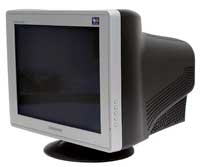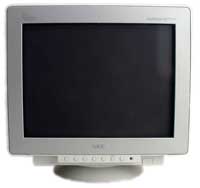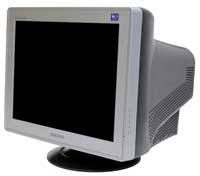Buyer's Guide - Entry Level, January 2005
by Jarred Walton on January 9, 2005 12:05 AM EST- Posted in
- Guides
Displays
For our displays, we continue to stick with CRTs due to pricing concerns - LCDs simply do not qualify as a budget part. The number of actual tube manufacturers is very small these days, as most display companies have moved on to the more profitable LCD sector, so differences between models are not all that great. What we really want out of a display is a decent refresh rate, a crisp picture, and above all, a flat surface. Convex monitors have been undesirable for over a decade, and we're more than willing to spend a bit more money in order to get a truly flat screen. This means that we're going with aperture grille displays, which some people do not like because of the two thin lines that are visible. We hardly notice the lines and will favor the flatter screens and brighter colors, but some people prefer invar shadow mask CRTs.  |
 |
| Click images to enlarge. | |
Display Recommendation: Samsung 793DF/793MB or NEC FE771SB 17" CRT
Price: $145 or $160 shipped
The best all-around option for a quality CRT is really a tie right now between the Samsung and the NEC offerings. NEC models tend to cost a bit more, but we're talking about a price difference of less than 10%. You can also find these displays at several of the larger computer stores, i.e. Best Buy and CompUSA, and when combined with special price discounts, you may be able to get them for substantially less money than we've listed here. As far as features go, both the Samsung and NEC displays are nearly identical. The NEC offers a feature called "Super Bright", which will bump up the brightness levels dramatically. It's almost painful to look at text with the SB mode turned on, but when watching movies or playing games, it actually works quite well. Samsung offers a similar feature with their "Magic Bright" technology - this is only available on the "MB" model and not on the "DF" model, however. As for the overall look, Samsung goes with a two-tone and NEC sticks with a solid color. Samsung also places the controls on the side of the monitor while NEC places them on the bottom. The two-tone color effect is one that you will probably either love or hate; personally, we think it looks pretty good and matches up with black or beige cases relatively well. As for the controls, we find the NEC positioning and menus to be more useful, but maybe we're just more used to that setup. Either one will get the job done quite well. Of course, it may be easier to find one or the other depending on where you shop.
The one feature that we miss is the lack of a 75 Hz or higher refresh rate at the maximum resolution. Unfortunately, this appears to be the case with nearly all 17" CRTs; finding a 17" monitor with a higher refresh rate is relatively difficult, and the only readily available option is Viewsonic. Unfortunately, we've heard quite a few bad experiences with Viewsonic monitors - many report that they burn out after a few years - and so we hesitate to recommend them. We feel that most displays should easily last 5 years, if not more, so when we see a lot of comments about replacing two Viewsonic CRTs in a five year span, it makes us nervous. Besides, you can get larger displays with higher supported resolutions and refresh rates for only a bit more than a "high-end" 17" CRT. Rather than spending $180 for a 17" display with an 85 Hz refresh rate at 1280x1024, we would just as soon spend the extra $20 to move up to a 19" CRT. That brings us to our alternative display recommendation.
Display Alternative: Samsung 997DF 19" CRT
Price: $215 shipped
Moving up to the realm of 19" displays, we feel that Samsung easily wins this category. They continue to offer a perfectly flat screen, and they increase the maximum resolution to 1920x1440. That may not be the most useful resolution for practical use, unless your eyesight is far better than average, but the1600x1200 resolution at a 75 Hz refresh rate is quite good. Unlike the 17" category, there are some differences between Samsung and the chief rival NEC FE991SB. NEC continues to offer their Super Bright mode while Samsung does not offer Magic Bright. It's a relatively minor omission, however, and not worth the additional $60 that the NEC would cost. NEC also offers a lower maximum resolution of 1792x1344, but considering both brands have a 96 KHz horizontal frequency, the useful resolutions are still basically a tie. If you can afford the additional $75 or so, a good quality 19" display can last a long time.
One thing that can be somewhat irritating is trying to find maximum supported refresh rates for monitors. Some companies are better than others at reporting such values, but others like to avoid listing such information as it may not meet expectations. If you can't find the maximum refresh rates for a monitor, the horizontal scanning frequency is usually enough to let you calculate what is available. A reasonable approximation of the refresh rate that a monitor can handle at a given resolution is to take the horizontal scanning frequency in Hz (it's usually expressed in KHz, so multiply by 1000), divide it by the number of lines of output for your chosen resolution - i.e. 1280x1024 would mean divide by 1024 - and then multiply by 0.97. The last multiplication by 97% is to allow for the time taken to reposition the electron beam between lines. For 85 Hz at 1280x1024, then, the horizontal frequency will need to be 90 KHz or higher. For 85 Hz at 1600x1200, you would need a horizontal frequency of 105 KHz or higher. Faster scanning frequencies require more sophisticated electronics, which is why most 17" monitors stick with a 70 KHz frequency, 19" monitors go with 96 KHz, and 21/22" displays will have the high-end 115+ KHz rates.
Update: The Samsung monitors actually are not aperture grille displays. That would explain the price difference between the NEC and Samsung models. They are still virtually flat, just like the NECs. This makes the decision between monitors a little more important, at least if you have strong feelings one way or the other on the topic of invar shadow mask vs. aperture grille displays. How noticeable is it? Well, I've had a Samsing 997DF for a couple months and have only just noticed (after a close look) that it was not an aperture grille.











31 Comments
View All Comments
justly - Monday, January 10, 2005 - link
Jarred, Thanks for the responce, and I can certainly understand why you would dislike writing a budget guide.If what you say is true "In a single review with high-end components (which is how we generally handle reviews), a lot of motherboards work very well. When you start dropping down to cheaper RAM, however, it's amazing how frequently system instabilities seem to end up being caused by the motherboard choice." then maybe what is really bothering me is not so much your review but the way motherboard reviews are conducted.
One other thing (just thinking out loud here), how does VIA and SiS chipset affect memory compatibility on a A64 system when the memory controller is part of the CPU??? Do the motherboard manufactures pay more attention to the memory trace lines on Nforce based motherboards (even budget ones) than SiS or VIA based boards??? ... I really think I need an answer to these before I can fully believe you, no offence but I will remain skeptical about your comment to not use VIA or SiS (at least on a A64) untill these are answered.
Maybe you could make a recommendation on how motherboard reviews are conducted, that way Anandtech readers can be informed about these problems that are hidden from us by reviews that only use high-end components.
Thanks again for the reply.
JarredWalton - Monday, January 10, 2005 - link
Good point, PrinceGaz. Of course, my take is that the ability to run the "full" Aero Glass experience mode of Longhorn is essentially a requirement for most people. At the very least, a PC should be upgradeable to that level (with AGP/PCIe cards, not with PCI).18 - I don't actually recommend the FX 5200 as a card for any of the systems. I mentioned it only as the "fastest" PCI graphics card currently available. The 9550 might also be available in PCI version, in which case it would be something of a toss up, but I haven't heard of any ATI DX9 parts for PCI.
#17 - Of course you can get a cheaper system that what I listed. What you've specced out is pretty much the cheapest "modern" system that could be put together. I personally wouldn't recommend that sort of configuration to a friend (or anyone else) without some serious reservations. Basically, it would be a case of "you can get this if you want, but I will not be held responsible for any shortcomings." You basically hit the point of diminishing returns, where $5 to $10 saved ends up costing you 10% of your overall performance (i.e. going from a Sempron 2400+ to a Sempron 2200+), or else you lose certain features that I consider desirable (DVD+RW support).
It's a personal preference, really, so people can go either way. My feeling is that any *new* system should include at bare minimum the following:
512 MB of RAM
80GB Hard Drive w/8MB cache
Sempron 2400+/Celeron D 320
17" monitor
DVD+RW support
You certainly don't *need* any of those features for standard PC use, but I would definitely recommend spending the extra $50 or so to get them.
PrinceGaz - Monday, January 10, 2005 - link
Excellent article, I couldn't really fault any of the choices, and good explanations were given of why they were selected.One minor point worth mentioning maybe related to Longhorn's graphics requirements, specifically where you say that for the "next version of Windows (codenamed Longhorn), 3D graphics support will actually be required in order to run it properly. Specifically, the word is that Pixel Shader 2.0 support will be required".It will run fine on DX7 hardware in 'Classic' mode (similar to how Windows 2000 looks). Only the 'Aero' and 'Aero Glass' modes require DX9 hardware. Full details on the likely requirements for the three modes can be found here-
http://www.microsoft.com/whdc/device/display/graph...
delldell - Monday, January 10, 2005 - link
Good article; however, the radeon 9550 graphics card is faster than the nvidia FX 5200 while also being cheaper :) At only $60 the 9550 clearly represents the best bang in the the low end video card market. Check out the review from techreport.comhttp://techreport.com/etc/2005q1/bestof2004/index....
ChineseDemocracyGNR - Monday, January 10, 2005 - link
I have a different idea of what a budget computer is.AMD budget:
AMD Sempron 2200+ Retail $54
ASRock K7S41 $49
Corsair Value Select 256MB DDR400 $41
Seagate 40GB 7200RPM 2MB PATA $56
LG 52X32X52 CD-RW Drive $29
same floppy, Case & PSU, Display, Speakers, Keyboard and Mouse as your AMD Budget. $251
Total: $480
AMD Performance Budget:
AMD Sempron 2600+ Retail $86
ASRock K7Upgrade-880 $47
Corsair Value Select 2x256MB DDR400 $68
Gigabyte ATI Radeon 9550 128MB DDR 128-bit $71
Seagate 80 GB 7200 RPM 8MB SATA $69
LG 52X32X52 CD-RW Drive $29
same floppy, Case & PSU, Display, Speakers, Keyboard and Mouse as your AMD Budget. $251
total = $621
Intel Budget:
Intel Celeron D 315 (2.26GHz) Retail $69
ASUS P4S800-MX $60
Corsair Value Select 256MB DDR400 $41
Seagate 40GB 7200RPM 2MB PATA $56
LG 52X32X52 CD-RW Drive $29
same floppy, Case & PSU, Display, Speakers, Keyboard and Mouse as your AMD Budget. $251
Total: $506
Intel Performance Budget:
Intel Celeron D 325J (2.53GHz) Retail $89
ASRock 775V88 $58
Corsair Value Select 2x256MB DDR400 $68
Gigabyte ATI Radeon 9550 128MB DDR 128-bit $71
Seagate 80 GB 7200 RPM 8MB SATA $69
LG 52X32X52 CD-RW Drive $29
same floppy, Case & PSU, Display, Speakers, Keyboard and Mouse as your AMD Budget. $251
total = $635
qquizz - Sunday, January 9, 2005 - link
Just to clarify:Of course ddr400 memory can run at 333 speed. My point is that the memory must be run at 333 to be supported by the motherboard using onboard graphics. This is the case with all NF2 boards with onboard graphics that I've seen.
Jep4444 - Sunday, January 9, 2005 - link
its mainly old Via boards with issues(i mean original K8T800) and for the purpouse of this article an NF3 can be had cheaper than a K8T800pro on 754 so it is a justified move but to say Via chipsets have problems is just not rightWhen it comes to 939 boards, the K8T800Pros(specifically from Abit and Asus) have been the best boards out
erinlegault - Sunday, January 9, 2005 - link
The one thing I think was missing from the graphics section is overclocking options. Overclocking is a great way to gain extra performance from a product. Besides what ATI and others do to turn a Radeon 9600 into a Pro or XT is overclock it and provide adequate cooling and provide faster memory. Why should a user pay a company to overclock a product when they can do it themselves.I personally like Abit's options. They have a line of products based on the Radeon 9550, just an underclocked 9600. But, they have two products, the R9550-Guru and the R9550XTurbo-Guru, which supports their V-Guru overclocking utility. With adequate cooling these products could posibly be overclocked to the 600 MHz of the 9600XT. On the memory, side the Guru has 3.6ns memory that is comparable to the 3.3ns memory of Abit's 9600XT product and probably can't be overclocked much above the stock 400 MHz. But, the interesting part about the XTurbo-Guru is that the memory is 2.5ns and can be easily overclocked. And if you look at the product images, I think adequate cooling is already provided for overclocking.
qquizz - Sunday, January 9, 2005 - link
It should be noted that for the budget motherboard: http://www.msicomputer.com/product/p_spec.asp?mode..."Supports DDR266/333 with internal graphic core, DDR266/333/400 with external add-on card."
In other words, if you wanna use ddr400, it is only supported if you use a discrete video card. If you use the onboard video, only ddr266/333 is supported.
JarredWalton - Sunday, January 9, 2005 - link
Justly - The memory compatibility issues with Nforce3 250 are pretty much confined to the EPoX boards as far as I've heard. All other NF3250 boards will run two DS DIMMs at DDR400. VIA chipsets in general still have some issues. The motherboard is such a critical component that I really don't like to cut any corners, even in the budget sector.In a single review with high-end components (which is how we generally handle reviews), a lot of motherboards work very well. When you start dropping down to cheaper RAM, however, it's amazing how frequently system instabilities seem to end up being caused by the motherboard choice.
Honestly, I dislike writing the budget guide selections, just because there are so many questionable parts. I always try to push customers to spend an extra $30 or so on the motherboard if nothing else. Maybe I'm just superstitious, but I've had several "cheap" systems fail after a year or so due to the motherboard.